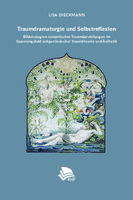Traumdramaturgie und Selbstreflexion: Bildstrategien romantischer Traumdarstellungen im Spannungsfeld zeitgenössischer Traumtheorie und Ästhetik
Abstract
The dissertation analyses dream images in romanticist art, with regards to inherent dreamanalogue strategies in consideration of contemporary dream theory and aesthetics, with a focus on the period between 1820 and 1840. The study does not provide a typological, iconographical or motif-historical collection of samples, but analyses different aspects of selected artworks which represent a wide range in terms of their contextual, formal and topographical heterogeneity, and overcomes the existing stereotypical classification in the context of romanticist art reflection. The study identifies that, beyond the contextual-iconographical dimension, the dream serves as an aesthetical category because it is reflected not only as a motif but also in relation to its dramaturgy. In the romantic awareness of the difficulty of an adequate representation of invisible images, the nonlinear, associative, ciphered, space- and time-simultaneous structure of the dream is adapted as a method, and is staged by varied and differentiated configurations. This is mirrored by comprehensive or formal concepts (genre, technique, media and interdisciplinary), as well as in fragmentary structures (sketches and drawings), in materiality (transparency and colour) or arabesque and combinatory production principles.
The study contains three chapters: after a general introduction to the subject, the analysis of the current state of research and the demonstration of the methodology in the first chapter, the second chapter focuses on contemporary dream discourses (especially the theories of Gotthilf Heinrich Schubert and Carl Gustav Carus) and the constitutive role of the philosophy of Friedrich Wilhelm Joseph Schelling. By also involving the literary concepts of dreams the romantic awareness of the deficiency of the visible image compared to the invisible, which forces an avoidance of a mimetic art perception, becomes obvious. The third chapter forms the main body of the study. On the basis of selected dream images it analyses the different artistic strategies and conditions of reception.
The first section of the third chapter focuses on artist dream imagery, namely the Musician’s Dream by Caspar David Friedrich, Raphael’s Dream by Franz and Johannes Riepenhausen and the Dream of Erwin von Steinbach by Moritz von Schwind. The analysis indicates that the dreaming artist serves as mise-en-abyme of the dream-analogue productive and reflexive process, and the artwork itself.
The second section of chapter three makes landscape spaces accessible as imaginative concepts and projections of emotional states, according to current literature studies. Landscape spaces serve as patterns for reflection processes, which is explored on the basis of The Dreamer by Caspar David Friedrich.
The third section of the third chapter focuses on a combinatory and arabesque concept as a dream-analogue and self-reflexive strategy – the collage-like compilation, association and transformation of heterogeneous elements which are analysed on the basis of the artworks Dream of Adam by Moritz von Schwind and The Evening by Clemens Brentano. Die Arbeit untersucht Bildstrategien von Traumdarstellungen der deutschen Romantik unter Berücksichtigung der zeitgenössischen Traumtheorie und Ästhetik mit einer Fokussierung auf den Zeitraum zwischen 1820 und 1840. Die Studie geht der Frage nach, ob die Traumdarstellung jenseits ihrer ikonographischen Dimension auch als ästhetisches Konzept fungiert, indem die Dramaturgie des Traumes als Methode eingesetzt wird. Die romantische Präferenz für das Unbewusste – gerade auch hinsichtlich der Kunstproduktion – zeigt sich in der Auseinandersetzung mit der philosophisch-literarischen Frühromantik und kulminiert in einer Ästhetik der inneren Bilder. Diese reflektiert die Darstellbarkeit unsichtbarer Bilder und findet in der alinearen, assoziativen, chiffrierten, raum- und zeitsimultanen Dramaturgie des Traums ihre adäquate Struktur, auch weil sie sich einer homogenen Werkgenese zu widersetzen vermag. Unter Berücksichtigung unterschiedlicher Aspekte analysiert die Arbeit ausgewählte und heterogene Beispiele von Traumdarstellungen, die als Ausdruck dieser (Selbst)reflexion gelesen werden können. Lesen Sie hier die detaillierte English Summary: http://bit.ly/1yxFcVi
Lisa Dieckmann promovierte 2013 im Fach Kunstgeschichte an der Universität zu Köln bei Prof. Dr. Susanne Wittekind, ist seit 2005 wissenschaftliche Mitarbeiterin und seit 2008 Geschäftsführerin von prometheus – das verteilte digitale Bildarchiv für Forschung & Lehre am Kunsthistorischen Institut der Universität zu Köln. Sie ist verantwortlich für das DFG-Projekt »Meta-Image – virtuelle Forschungsumgebung für den Bilddiskurs in den Kunst- und Bildwissenschaften«, außerdem Gründungsmitglied des Cologne Center for eHumanties und Sprecherin des Arbeitskreises Digitale Kunstgeschichte.
Keywords
romantik; ästhetik; dream theory; künste; traumtheorie; 19. jahrhundert; 19th century; romantic; arts; aesthetics; Friedrich Wilhelm Joseph Schelling; PhilosophieDOI
10.16994/babISBN
9783946198031;9783946198017;9783946198024OCN
1030816055Publisher
Modern Academic PublishingPublisher website
https://www.humanities-map.net/Publication date and place
Cologne, 2016Classification
The Arts
Theory of art
History of art
Romanticism
History
Philosophy: aesthetics


 Download
Download Web Shop
Web Shop